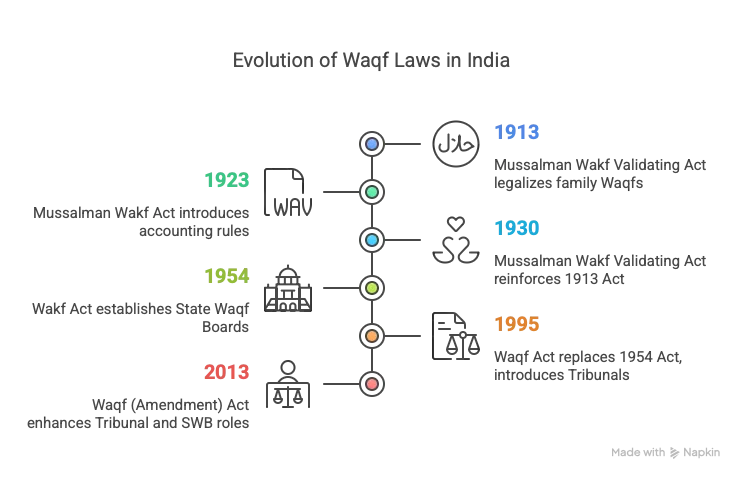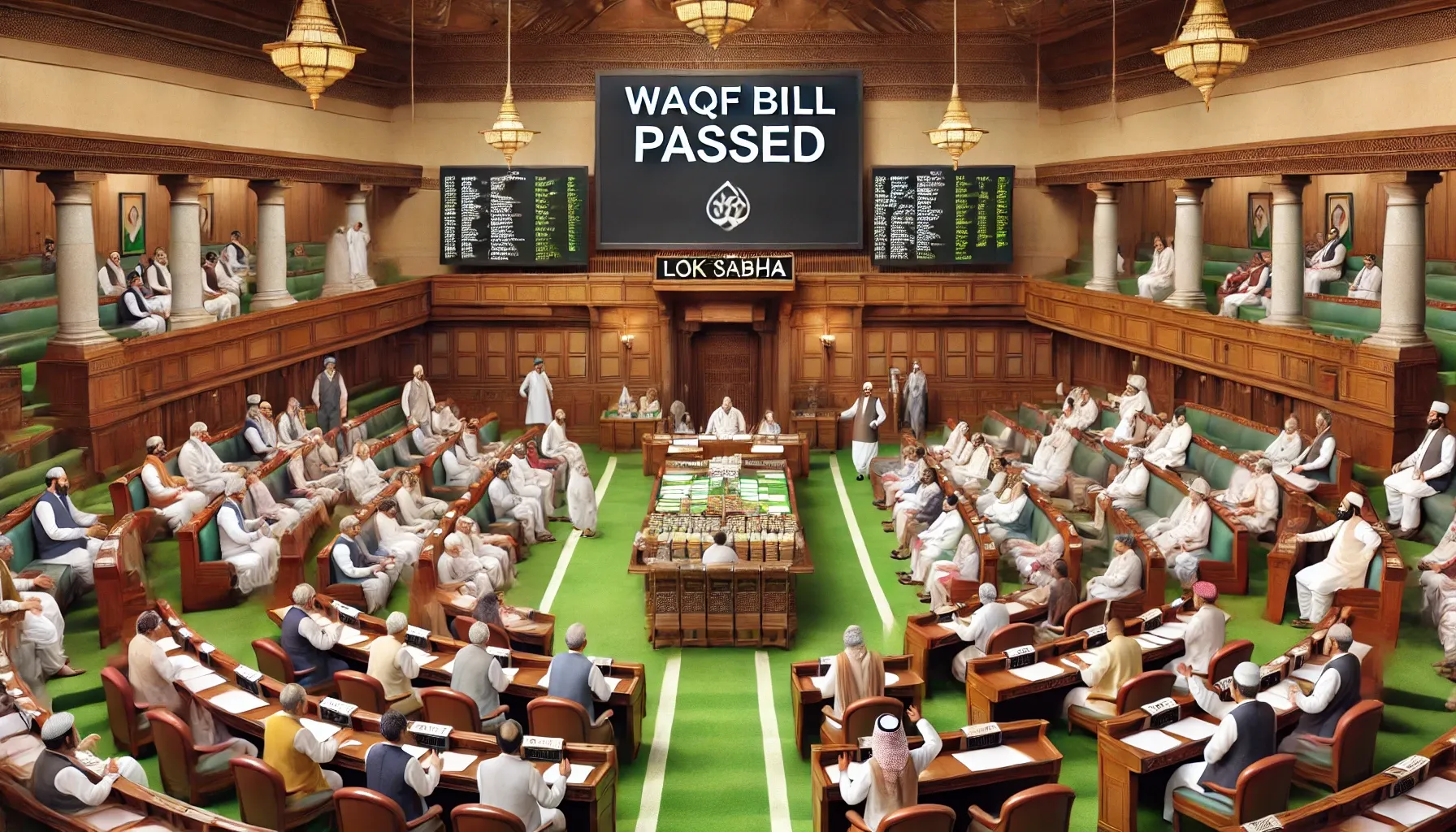UPSC
PIB
Waqf Amendment Bill 2025: Evolution and Impact on Governance
Last Updated
4th April, 2025
Date Published
4th April, 2025
Share This Post With Someone

The Waqf Amendment Bill, 2025, represents a significant legislative step in India to modernize the management of Waqf properties, rooted in Islamic tradition for charitable and religious purposes. Understanding its historical evolution, proposed reforms, and socio-economic benefits provides critical insights into governance, social justice, and economic policy, essential for aspirants preparing for competitive examinations.

Information in Points
Historical Evolution of Waqf Laws in India
- Definition of Waqf: A permanent dedication of movable or immovable property by a Muslim for pious, religious, or charitable purposes under Muslim law, inalienable and vested in God.
- Mussalman Wakf Validating Act, 1913: Legalized family Waqfs with eventual charitable intent, though less effective in management.
- Mussalman Wakf Act, 1923: Introduced accounting and transparency rules for Waqf management.
- Mussalman Wakf Validating Act, 1930: Reinforced legal validity of family Waqfs, supporting the 1913 Act.
- Wakf Act, 1954: Established State Waqf Boards (SWBs) for oversight, created the Central Waqf Council (CWC) in 1964 for supervision, marking centralized governance post-Independence.
- Amendments (1959, 1964, 1969, 1984): Enhanced administrative efficiency of Waqf properties.
- Waqf Act, 1995: Replaced the 1954 Act, introduced Waqf Tribunals (special courts with civil court powers), made tribunal decisions final, defined roles of CWC, SWBs, and mutawallis (caretakers).
- Waqf (Amendment) Act, 2013: Added three-member Waqf Tribunals with a Muslim law expert, mandated two women in SWBs, banned sale/gifting of Waqf properties, extended lease periods from 3 to 30 years.
Waqf Amendment Bill, 2025 - Overview and Objectives
- Introduction: Aimed at modernizing Waqf administration, reducing disputes, and enhancing efficiency; paired with the Mussalman Wakf (Repeal) Bill, 2024, to repeal the 1923 Act.
- Administrative Bodies: CWC advises on policy, SWBs manage properties, and Waqf Tribunals resolve disputes.
- Key Issues Addressed: Lack of transparency, incomplete surveys, women’s inheritance rights, rising litigations (10,381 cases in 2013 to 21,618 now), irrational Waqf Board powers, government land disputes, poor auditing, administrative inefficiencies, trust mismanagement, and inadequate stakeholder representation.
Modernisation and Benefits of the Bill
- Non-Muslim Property Claims: Addresses disputes over 5,973 government properties claimed as Waqf (data from September 2024 across 25 States/UTs).
- Examples: Tamil Nadu farmer unable to sell land due to Waqf claim; Bihar’s Govindpur village case in Patna High Court; 600 Christian families in Kerala contesting claims; 15,000 acres in Karnataka’s Vijayapura disputed; Punjab Waqf claiming Education Department land; MoHUA reporting 361 properties under litigation.
- Women’s Rights: Enhances socio-economic status of Muslim women, especially widows and divorcees.
- Provisions: Waqf-alal-aulad supports widows, divorced women, and orphans (Section 3(r)(w)); retains two women in SWBs (Section 14) and CWC (Section 9); ensures female heirs’ inheritance via Section 3A(2); promotes gender justice through scholarships, healthcare, skill development, legal aid, and pensions.
- Upliftment of the Poor:
- Digitization: Centralized portal for tracking properties, auditing to prevent mismanagement, boosting transparency.
- Revenue Increase: Prevents misuse, funds welfare like healthcare, education, housing, and livelihoods.
- Administrative Reforms: Enhances transparency, coordinates SWBs with local authorities, protects stakeholder rights.
- Inclusivity: Mandates representation from Bohra, Aghakhani, backward classes, Shia, Sunni, and two non-Muslim members (excluding ex-officio) in SWBs/CWC; includes elected municipal/Panchayat members.
Waqf Property Statistics (As of September 2024)
- Total Properties: 8.72 lakh across 38 lakh acres (30 States/UTs, 32 Boards).
- Breakdown: 356,350 estates, 872,802 immovable properties, 16,716 movable properties, 330,008 digitized records.
- Waqf by User: 4.02 lakh properties; only 9,279 ownership deeds and 1,083 Waqf deeds uploaded on WAMSI portal.
- State-wise Data: Examples include Uttar Pradesh Sunni Board (217,161 properties), Tamil Nadu (66,092 properties, 655,003.2 acres), Karnataka (62,830 properties, 596,516.61 acres), and Jammu & Kashmir (32,533 properties, 350,300.75 acres).
Schemes by Ministry of Minority Affairs
- Quami Waqf Board Taraqqiati Scheme (QWBTS): Grants-in-aid for digitizing records and manpower deployment; Rs 23.87 crore spent (2019-24).
- Shahari Waqf Sampatti Vikas Yojana (SWSVY): Interest-free loans for commercial development; Rs 7.16 crore spent (2019-24).
Conclusion
- Bill’s Impact: Establishes a secular, transparent, and accountable Waqf system, aligning with legal and administrative governance rather than religious control, ensuring public interest and stakeholder empowerment.
Glossary
- Waqf: Permanent dedication of property for pious, religious, or charitable purposes under Muslim law.
- Waqf-alal-aulad: Family Waqf allowing income to support widows, divorced women, and orphans.
- Central Waqf Council (CWC): Advisory body overseeing Waqf policy and State Waqf Boards.
- State Waqf Boards (SWBs): State-level bodies managing Waqf properties.
- Waqf Tribunals: Special courts resolving Waqf disputes.
- Mutawalli: Caretaker or manager of Waqf property.
- Digitization: Use of a centralized portal to track and manage Waqf properties.
- WAMSI Portal: Online platform for Waqf property records and management.

UPSC
Indian Express Concise

UPSC
The Hindu Briefs